A Very Strange, yet Interesting Place
It was time to return to Sintra after taking a day of R&R at the house and visiting our charming little home base town of Caldos da Rainha. Sintra is a challenge in many ways due to its popularity and no challenge is greater than finding a place to park. We were astounded to find a spot right in the middle of town and equally astounded to receive a parking ticket later in the day. Michael crafted a compelling email to the authorities highlighting their lack of signage, snaky practices and their contributing to making Sintra even more annoying than previously believed. The authorities apparently agreed because we have heard nothing more.
Once parked, we began the trek to Quinta da Regaleira - an entirely quirky 4 hectare Estate that defies easy description. The estate was begun in the early to mid 1800s but the major work was done between 1890 and 1910. This was the height of the romantic period of architecture in Portugal and when most of the major Sintra palaces were constructed. I will spare you an in depth discussion of the architecture since it seems to include at least five or six styles. Let's just call it eclectic.
The primary owner was a rich coffee grower named Montero who emigrated from Brazil to Portugal.. He was seriously into symbolism and ideologies (many) with arcane references scattered in art, fountains and tunnels throughout the "park". The most dramatic feature is the Well of Initiation which consists of a spiral staircase of nine levels descending into the earth. So, why is it called the Well of Initiation? It appears that Montero was a devotee of the Knights of Templar which thrived between the 1100s and 1300s but then petered out. Their rituals were revived by organizations like the Masons and it is believed that Initiations into that or a similar group were conducted at the well. Accounts state that initiates were blindfolded and they held a saber close to their heart. They then had to descend the nine levels and enter a warren of tunnels and find their way through the tunnels to the light visible in front of the chapel where they were formally inducted into the order. The nine levels represent either the nine founders of the Templars or the nine circles of Dante's hell - you pick.
Having performed this ritual without a saber or blindfold I have great appreciation for what they went through. Each set of steps grows increasingly dark and the tunnels are uneven, claustrophobic and creepy. However, you have to admire the effort that went into the construction. Most dramatic was the Waterfall Lake. Michael's photos will reveal all.
 |
| The Palace of Quinta da Regaleira. |
 |
| The stables were quite nice with amazing woodwork on the stalls and a fancy water trough for the horses. |
 |
| In the garden on the estate there was a tower, with various viewing levels. |
 |
| Looking down into the Well of Initiation from the top... |
 |
| and looking up from the bottom. |
 |
| The waterfall into the Lake (or more accurately a small pond). |
 |
| Inside the caverns after descending the stairs in the Well. It was fairly well lit, but you can imagine if there were only a few candles to light your way. |
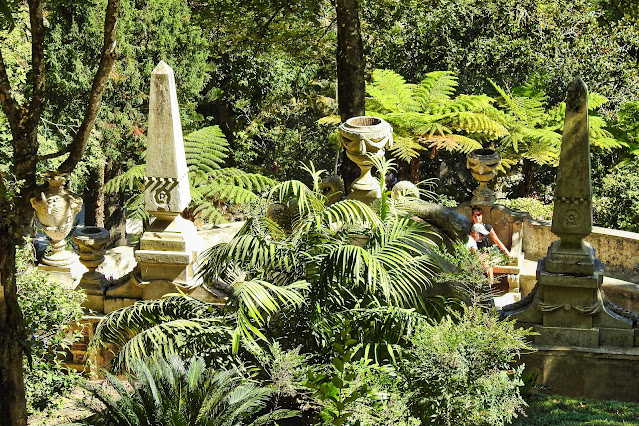 |
| The gardens on the estate designed in the style of the Romantic Period with its stone benches and decorative stone work... |
 |
| along with the tiled backdrop to the fountain were impressive. |
 |
| Another view of the Palace with its many towers and five floors. |
 |
| My sister Mary with her husband Mike. |
 |
| A grotto and pond on the estate. |
 |
| The estate had its own chapel with fabulous stone work at the entrance... |
 |
| and in the interior as well. The chapel is dedicated to the Holy Trinity and has a hidden crypt. It also has a tunnel leading to the Palace. |
 |
| You may remember the "miracle" of Navarre from a previous blog. Here in the chapel in Sintra is a depiction of the "miracle" in stained glass. |
 |
| The Eye of Providence, a freemason symbol, first appeared in a Renaissance painting in 1525 titled Supper at Emmaus as a symbol of God's watchfulness over all. |
 |
| More of the decorative stonework in the garden, filled with religious symbolsim. |
 |
| The rope stonework is particularly realistic of real rope. |
 |
| The entrance to the estate house also has the intricately carved stonework. |
 |
| The mosaic tile floor,... |
 |
| the tiled walls,... |
 |
| the carved wood ceilings,... |
 |
| and the painted panels on the wall... |
 |
| all showed the care for opulence that went into the interior design of the house. |
 |
| The lion with its tongue sticking out seemed to be a common theme on these door escutcheons and door handles, as seen in this series of photos. |
 |
| One more view of the side of the Palace, which was designed with many secret passages. |
It was time to wend our way back to the car and to lunch. Michael put the restaurant name into GPS, pushed the happy little walking figure and we were off. Here is my gripe with GPS and walking. It gives you the shortest point between two points-- not the easiest. We probably saved a few steps from the way we took going to the Quinta but the "shortest" route involved mountain goat challenging ascents followed by knee crushing descents. They should fix that. But lunch was good and we all decided we'd had enough for one day.
 |
| A very colorful house across from the restaurant where we ate. |
 |
| The tower of the town hall. |
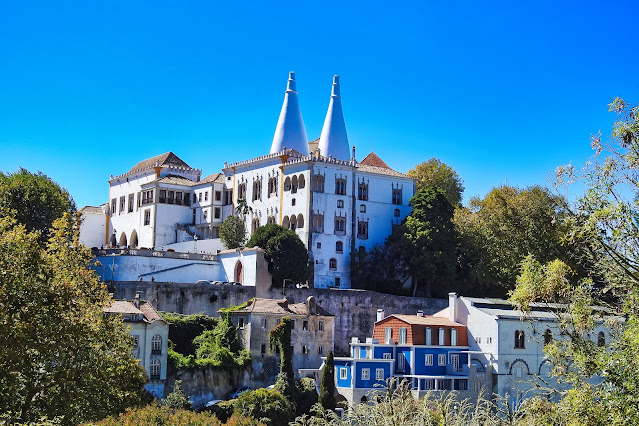 |
| Another view of the Palace of Sintra, with its two iconic coned shaped towers. |
 |
| Some of the houses of Sintra were quite interesting... |
 |
| as can be seen in these two photos. |
 |
| There was some very interesting sculptures on our walk from the restaurant to our car. |
A Wild and Wooly Penninsula
It was our last day before we had to leave the house. We decided to take a short ride to a peninsula that offered amazing views. There is not much to say about it except that it is the beginning of the E9 Coastal Trail that runs for 9,980 kilometers from Portugal to Estonia. It is the longest continuous trail in the world. Good trivia question. The photos show the power of the Atlantic on the Portuguese coast.
 |
| This series of photos shows the power of the Atlantic, as it hits the rocky coast of Portugal on the Peniche peninsula. |
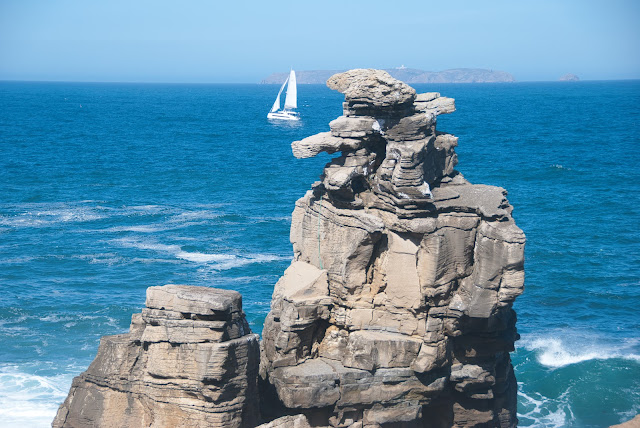 |
| The rock, the sailboat and the island in the background made for a fascinating photo. |
 |
| The Farol (lighthouse) do Cabo Carvoeiro dates back to 1790. |
The Scattering of the Searles
The week ended and it was time for the sibs to strike out on their own. Some went to the Algarve, others to Lisbon and Theresa and Marshall returned to Dallas to light a fire under their contractors who were dilly dallying in finishing their massive renovation.
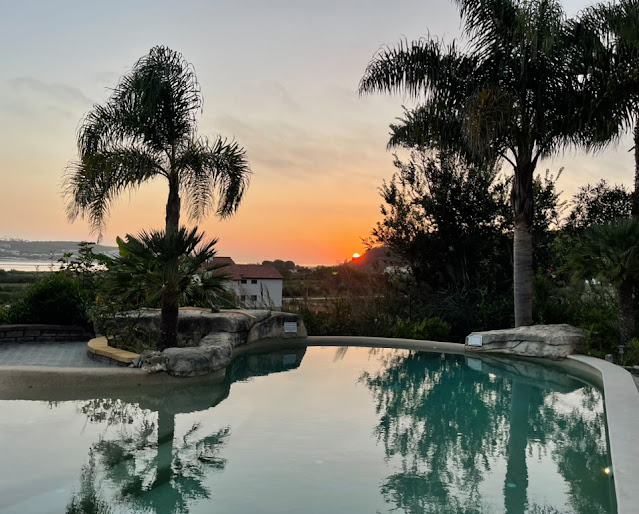 |
A sunset view from the pool of the house where we were staying.
|
 |
| My brother-in-law Michael & sister Patricia, who prepared this port tasting paired with chocolate for all of our delight. |
 |
| The white port, tawny port and vintage port each paired with its own chocolate. |






































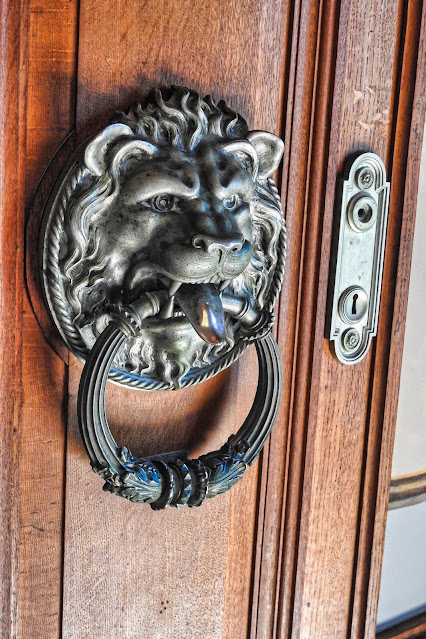

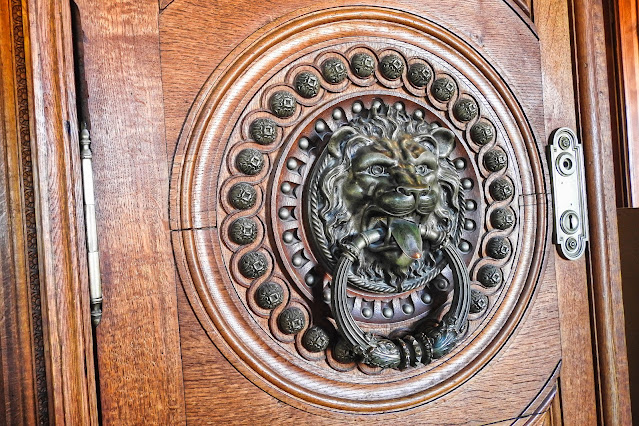









Hope you indulged with the wine and chocolate tasting! Great read!
ReplyDelete